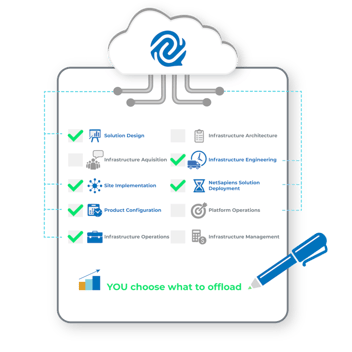Workplace Management in a Remote Office: Communication is Key
Managing remote workers and improving your at-home workforce effectively means understanding the challenges remote workers face and taking steps to mitigate those challenges.
Remote work and hybrid work arrangements where employees split time between home and office have become mainstream, creating efficiencies, conveniences, and all-new ways to work. But the model isn't without its challenges. Managers, supervisors, and company executives must align workplace policies and practices with remote teams' functions to run smoothly.

A 2022 study by McKinsey reports that 58% of US workers now have the opportunity to work from home at least some of the time. More than a third of all workers have been offered remote work on a full-time basis, which indicates that remote work will continue to be a significant part of workplace experience.
Remote Workplace Challenges
Managing remote workplace challenges is easier than you might think. Technology has made remote work more accessible and more manageable for employees and the companies they work for. These are the challenges management has to navigate for a successful remote workforce.
Remote Supervision
For both managers and employees, remote supervision differs from sitting in the office. Supervisors worry that employees may not be productive, while employees may feel they need more guidance. At the same time, workers may also feel their work may go unnoticed as they are out of sight, out of mind.
Disconnected with the Workplace
Remote workers may also feel disconnected from their colleagues. There’s significantly less face-to-face interaction. Connecting with team members requires a proactive approach rather than regular office interaction during the day.
Workers may feel out of touch with what’s going on with their coworkers, worry about missing important information, and lack access to the people they need to work efficiently.
Isolation
One of the more common complaints from remote workers is a sense of isolation. This can lead to loneliness and even depression among workers.
Distractions
At-home workers have plenty of distractions that can take focus away from their job. Children, pets, laundry — it can all add up. Even when working in the office, home life can sometimes intrude. When working at home, it’s front and center.
Supporting the Remote Work Environment
So, how can you support remote workers and overcome these workplace challenges? In every case, the answer is communication. Managers need a communications plan to keep in touch and help remote team members.
This starts with the right communication tools and structure.
The Right Communication Tools
You’ll need a comprehensive business communications solution when managing a remote workplace. Everyone needs to be connected in a unified way to facilitate smooth communication when working remotely. This requires tools that help foster engagement and collaboration.
Switching to a business VoIP solution with a hosted private branch exchange (PBX), for example, can extend the in-office functionality to remote workers by installing softphones or mobile apps on their home computer, laptop, tablet, or other connected devices. This allows them to make and receive calls and leverage advanced calling features from wherever they work.
Unified communications bring together tools such as video conferencing, instant messaging, file sharing, and collaboration platforms into a unified tech stack.
Moving Operations to the Cloud
To make resources available to in-office and remote workers, organizations need to invest in digitizing and moving resources to the cloud. Remote employees need access to files, data, and documentation without relying on email or other employees to get it for them.
One of the most frustrating aspects of working remotely is the inability to access the data and information you need and depend on others to get it. This slows productivity and ties up multiple team members. As such, cloud migration is crucial to managing employees in a remote work environment.
The Right Structure
Getting everyone to commit to using unified communications with the company’s preferred communication method ensures everyone is on the same page. It makes sure information doesn’t get trapped in silos and is accessible to the entire team, whether they’re working in the office or at home.
This also makes it significantly easy for today’s hybrid workers, who work remotely on some days. It is much easier to move back and forth when everyone uses the same tools and has the same functionality at home and work.
With nearly three-quarters of US companies using or planning to allow some form of remote or hybrid work, providing consistent tools and communication is essential.
Your structure will need documented systems and procedures. With these systems, remote workers can save time trying to figure out how to do something or track someone down that can help. Developing standard operating procedures (SOPs), org charts, whom to contact for what, and how-to guides can save a lot of time.
Onboarding and Training for Remote Teams
The onboarding process for remote teams and the ongoing training they continue to receive are just as important.
Remote workers need a better understanding of a company's operations and remote-specific training. Remote workers must be reasonably tech-savvy to navigate collaboration and communication tools and work independently. This may require additional training beyond what in-office workers get.
Schedule Formal and Informal Meetings
Including formal and informal meetings in your communications plan is a good idea. Many companies do daily check-ins with remote workers at a pre-set time to keep the lines of communication open, discuss work progress, and identify any issues.
Check-ins may be one on one or group sessions. Most business consultants recommend both. Remote team members need to know their managers are available and make time to meet. A regular schedule of check-ins can help keep team members connected.
Many remote team managers also set aside specific times to answer questions or allow remote workers to book meetings with them. Remote workers can’t just walk down the hall and knock on the door, so giving them time to talk with their supervisors directly is helpful.
At the same time, informal meetings are essential, too. In the office, some of the best conversations and ideas result from impromptu gatherings in the lunchroom, hallways, or while walking through work areas. Managers shouldn’t be afraid to foster these informal interactions as well.
Maintain the Company Culture
In a recent report from PwC, just 5% of executives surveyed said they were confident they could maintain the company culture for remote teams unless they returned to the office. Yet, culture is crucial to company success and team member retention.
This means executives must pay attention to establishing and supporting the culture when managing remote teams. This requires:
- Clear objectives that tie work to the mission
- Reinforcement of mission and goals
- Prioritizing meaningful work
- Scheduling regular facetime
Make sure you include remote teams in your interactions with in-office workers, including team building and celebrating milestones.
Set Clear Expectations, and Don’t Micro-manage
It’s crucial that supervisors set clear expectations for remote workers. Remote teams need to know the rules and how they will be assessed.
A study of more than 60,000 remote workers found that employees working from home performed significantly higher on short-term projects and improved productivity. However, they did not act as well on long-term initiatives. Experts suggest that it’s easier to focus on tasks and harder to stay committed to longer-term goals. Remote teams may not have the same level of support, feedback, or goal reinforcement they get when at the office.
Regardless, setting clear expectations and maintaining regular communication is crucial to efficient and productive performance.
However, managers need to be extremely careful about micromanaging remote team members. With clear expectations, remote employees should be judged on work output rather than project time. In the office, it’s easy for some workers to look busy even if they’re not accomplishing much. With remote teams, it’s the work that counts.
Building an environment of trust in your remote teams will pay dividends. Ultimately, if you can’t trust your remote workers to work somewhat independently, they probably aren’t suitable for the job.
Managing the Remote Work Environment
As more employees seek remote work opportunities, companies will need a robust system and communications plan to recruit and retain top performers looking for remote work.
Simplicity VoIP is a nationwide leader in VoIP, hosted PBX, business telephone solutions, and comprehensive, unified communications for small, medium, and enterprise-level businesses. To see how you can improve your communications to manage remote team members better, contact Simplicity VoIP today.





